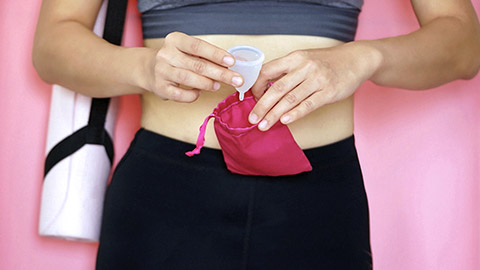Recall that there are 11 systems in the human body, working together to maintain homeostasis.
You have learned about the core systems essential for personal trainers to know, and your assessments for this module focus on these 5 systems:
- Skeletal
- Nervous
- Cardiovascular
- Respiratory
- Muscular
However, having an awareness of the other systems in the body, and how they impact health and fitness, will enrich your knowledge of human anatomy and physiology, and make you a more well-rounded personal trainer.
In this topic, we will cover:
- Endocrine system
- Lymphatic system
- Digestive system
- Menstrual cycle
This topic is intended to introduce these systems but is not as in-depth as previous topics. If these systems interest you, you are encouraged to do further research.
The endocrine (hormone) system is the system responsible for internal communication between organs and tissue. It does this through the release and production of hormones.
It is made up of specialised endocrine glands that secrete hormones into the bloodstream. These hormones are chemical messengers and will tell tissues or organs to either increase or decrease activity.
Watch
This video provides an overview of what the endocrine system is, and how it works.
Communication feedback
Many communication feedback loops play a key role in the body’s response to external and internal stimuli. These stimuli include things such as stress, sexual reproduction/regulation, and stimulation of cell growth and repair. When we compare the “hormonal communication” system to the “nervous communication” system, it’s easy to differentiate them as the slower communicators (hormonal system) and the quicker communicator (nervous system).
Hormones affect the body over a longer duration. The outcomes of hormonal releases and ‘imbalances’ do not result in an instant or acute physical response, and usually take hours or days.
We do not have the conscious ability to control the volume, intensity, or frequency of hormonal release within the body. However, we do have a clear understanding of the environmental (internal and external) factors that up-regulate, maintain, or suppress specific hormones and their release.
Hormonal profile
When looking at a person’s “hormonal profile” there are clear differences between sexes, but plenty of variance within sexes as well. For example, men do not go through a menstrual cycle which equates to a subsequent difference and need in testosterone and estrogen levels. Men tend to build muscle quicker than females due to the hormonal up-regulation of hormones like IGF-1 and testosterone when muscle cells are subject to a hypertrophic internal environment.
What about anabolic steroids?
Unsurprisingly, in the world of high-performance and resistance training, anabolic steroids and performance-enhancing drugs are present. Ethics aside, their purpose is to mimic the ‘preferred natural hormonal responses’ to things like metabolic stress and muscle tearing (repair).
Steriods don’t make your muscles bigger, but they allow you to respond to the focused stress applied to the body better, thus creating a more effective recovery response. The quicker and more effectively someone recovers, the more intensity, and volume they can tolerate in their training.
One of the major risks often associated with such PEDs is the body’s homeostasis response. “If I’m getting an adequate volume of hormone X externally for homeostasis’ sake, I might as well start deregulating the amount and frequency of my organ’s natural production of the relative hormone, signalling the body to stop producing hormones due to the fact it’s getting enough externally." This can potentially start a snowball effect of hormonal imbalance and health issues.
Why is it important to know about the endocrine system as a personal trainer?
Many of your clients will be subjecting themselves and their bodies to new stresses and environments. They may have never done resistance training before, they may not be used to being in a crowded, socially awkward, possibly judgemental place like a commercial gym at 5 pm on a Monday.
Stress is stress. Some stress is good, but too much isn’t great. Getting to know our clients allows us to figure out how they respond to stress mentally and physically (over time). Knowing how your client responds to the training stimulus you are applying is crucial in fine-tuning your client’s programming moving forward.
Most importantly, you want them to feel good! You can maximise the “goodness” by facilitating a relationship where your client makes positive health choices that improves their health.
Key hormones to know
The key hormones you should be aware of are:
| Cortisol | Plays an important regulatory role in metabolic responses. |
|---|---|
| Testosterone | Develops and maintenance of muscle mass and strength. |
| Oestrogen | Regulates the menstrual cycle and affects the reproductive tract, urinary tract, heart and blood vessels, pelvic muscles, and the brain. |
| IGF-1 (Insulin-like Growth Factor 1) | Manages the effects of growth hormone (GH) in your body and promotes the growth of bones and tissues. GH levels in the blood fluctuate throughout the day depending on diet and activity. |
| HGH (Human growth horome) | HGH is important for growth, cell regeneration, and cell reproduction. It helps speed up healing after an injury and repairs muscle tissue after exercise. |
| Insulin | Regulates the body's energy supply by balancing micronutrient levels during the fed state. It is crucial for transporting intracellular glucose to insulin-dependent cells and tissues like the liver, muscle, and adipose tissue. |
| Melatonin | Plays a role in the sleep-wake cycle. Natural levels of melatonin are highest in the evening. |
| Endorphins (oxytocin, seratonin, dopamine) | Your body releases endorphins during pain or stress, and during exercise, massage, eating, and sex. They help relieve pain, reduce stress, and improve wellbeing. |
Dealing with hormonal shifts
Whether you like it or not, we know that if we don’t get enough sleep, we struggle with focus, perceived energy, and performance. We know that if we become too stressed we are more prone to feeling sick and run down. High cortisol levels can suppress immune function. We know that if we create enough time under tension and metabolic stress via a hypertrophy resistance program, our muscles will hurt and then repair/grow (assuming other factors align to create an anabolic response).
We experience the outcomes of hormonal communication within our bodies all the time.
Homeostasis is attempting to create balance via hormonal communication 24/7. Awareness of the physical and mental outcomes of training and life stimulus, and recognising hormonal shifts in ourselves is a vital component of progressing and adapting our approaches to exercise and health.
The lymphatic system is another communication system within the body that closely aligns with the function (and is part of) the immune system. If the immune system is responsible for fighting “foreign invaders” in the body, and the circulatory system is responsible for transporting nutrients and blood around the body, the lymphatic system is the 3rd wheel to that relationship.
It has a circulatory function. Lymph, also known as interstitial fluid, moves around the body via the lymphatic system. As this fluid moves through lymph nodes (checkpoints) around the body, the body, more specifically white blood cells, check for anything irregular.
Watch
This short video provides an overview of the lymphatic system, including its structure and how it functions.
Key takeaways for personal trainers
The lymphatic system does not have a pump like the circulatory system, i.e., the heart. There isn’t pressure pushing the fluid around the body and through the checkpoints. The only way it can move fluid around the body (and effectively ensure the immune system can pick up potential sickness or foreign bodies) is to stimulate muscular contractions.
Exercise and skeletal muscular contractions push and create pressure on the lymph highways throughout the body to move the fluid around. Being more physically active can literally improve your body’s immune function and “tagging” potential foreign bodies.
The end of the lymph highway is the digestive system, and interstitial fluid is passed into the lower digestive tract.
Here's a pro tip for foam rolling: By rolling towards the digestive system (torso), you move lymph in the right direction. E.g., roll upwards when foam rolling the legs, and down for the lats. This will aid in the movement of Lymph fluid in the right direction.

The digestive system is the biological set of pipes between the mouth and bottom (anus) that converts food and liquids into different forms of energy and nutrients via chemical reactions.
It plays a vital role in breaking down the foods we eat into components we can absorb: Macronutrients and micronutrients.
Having an appropriate level of micronutrients in the body is an important aspect of health, and maintaining a positive energy balance is also a good indicator of health. If we look at the simplified model of energy in vs energy out: The choices around “energy in” matter (as do "energy out" choices). But, the health and efficacy of the digestive system as a whole are integral in creating positive health outcomes too.
In other words, it’s about what happens in between the “energy in” and “energy out”. We all understand the basics of digestion. We have seen things go in and come out. And we've felt the effects of an upset stomach or an “irregular” bowel movement. Who knows, one of the headaches you have had in the past could have been the outcome of a mild digestive issue.
Watch
This video provides an overview of the digestive system, and how it transforms food into nutrients and energy.
How diet impacts the digestive system
What we put in our mouth is affected by our digestive system via a chemical process within the organs and body. But our digestive system is also affected by what we put in our mouths. The simple analogy here is if you put diesel in a petrol engine, the engine will not have a good time.
Key points for personal trainers
It’s important to understand the digestive system as a personal trainer because your client requires:
- adequate energy balance to engage in resistance training.
- adequate nutrition to ensure recovery and adaptations from training occur.
- good mental wellbeing and the digestive system and process play a big part in this.
- focus, ability, and engagement within a session and the health decisions required outside sessions are heavily influenced by an effective digestive system.
The menstrual cycle begins when a person gets their period. Menstruation (a period) is the shedding of the uterine lining. This cycle is part of the reproductive cycle and prepares the body for a possible pregnancy. The menstrual cycle is controlled by the hypothalamus, pituitary gland, and ovaries. A typical cycle lasts between 24 and 38 days.
Phases of the menstrual cycle
Menstruation typically occurs once a month, starting around puberty and continuing until menopause. It can be divided into 2 - 5 phases depending on how specific you want to be. We'll consider 4 main phases:
| Menses | Typically lasts from day 1 to day 5. This is when the lining of the uterus is shed through the vagina if pregnancy hasn't occurred. Bleeding usually lasts between 3 and 7 days. |
|---|---|
| Follicular (also known as proliferative) | Typically from day 6 to day 14. Oestrogen rises, which causes the uterine lining (endometrium) to grow and thicken. Follicle-stimulating hormone (FSH) causes follicles in the ovaries to grow. During the later part of the follicular phase, one of the developing follicles will form a fully mature egg (ovum). |
| Ovulation | Roughly day 14 of a 28-day cycle. A sudden increase in luteinizing hormone (LH) causes the ovary to release the ovum. |
| Luteal (also known as secretory) | Typically from day 15 to day 28. The ovum leaves the ovary and travels down the fallopian tubes to the uterus. Progesterone rises to prepare the endometrium for pregnancy. If the ovum is fertilised by sperm and attaches to the uterine wall, pregnancy will occur. If this does not happen, oestrogen and progesterone levels drop and the lining will be shed. |
The menstrual cycle can vary in length and can be affected by various factors such as stress, illness, and medications. Abnormalities in the menstrual cycle, such as irregular periods or absent periods, can indicate underlying health issues and should be evaluated by a healthcare provider.
Impact on exercise

The menstrual cycle can impact a person's energy levels, strength, and endurance during exercise. These fluctuations may be due to changes in hormone levels and fluid balance during different phases of the menstrual cycle.
During the follicular phase, which occurs in the first half of the menstrual cycle, oestrogen levels are typically low and progesterone levels are high. This can lead to a lower level of energy and potentially lower strength and endurance. As oestrogen levels increase and progesterone levels decrease during the latter half of the menstrual cycle, energy levels may increase and strength and endurance may improve.
It is important for personal trainers to be aware of the menstrual cycle and its potential effects on their clients. You may need to adjust training plans and modify intensity or volume as needed. It is also important to remember that every person is unique and may experience different effects of the menstrual cycle on their training.
It is important for personal trainers to respect the individual needs and preferences of their clients when it comes to discussing and addressing the menstrual cycle and its impact on training. Some clients may be comfortable discussing their menstrual cycle and how it affects their training, while others may not want to discuss it at all. It is important for personal trainers to respect their clients' boundaries and privacy.
Read
To learn how to adjust training sessions to hormonal fluctuations of the menstrual cycle, read this article by Dr Stacy Sims: Nail a PR at Every Phase of Your Menstrual Cycle.
